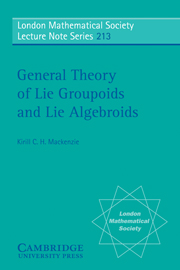Book contents
- Frontmatter
- Contents
- Prologue
- Introduction
- Preface
- TERMINOLOGY AND NOTATION
- ACKNOWLEDGEMENTS
- PART ONE THE GENERAL THEORY
- 1 Lie Groupoids: Fundamental Theory
- 2 Lie Groupoids: Algebraic Constructions
- 3 Lie Algebroids: Fundamental Theory
- 4 Lie Algebroids: Algebraic Constructions
- PART TWO THE TRANSITIVE THEORY
- PART THREE THE POISSON AND SYMPLECTIC THEORIES
- Appendix
- Bibliography
- Index
2 - Lie Groupoids: Algebraic Constructions
from PART ONE - THE GENERAL THEORY
Published online by Cambridge University Press: 05 April 2013
- Frontmatter
- Contents
- Prologue
- Introduction
- Preface
- TERMINOLOGY AND NOTATION
- ACKNOWLEDGEMENTS
- PART ONE THE GENERAL THEORY
- 1 Lie Groupoids: Fundamental Theory
- 2 Lie Groupoids: Algebraic Constructions
- 3 Lie Algebroids: Fundamental Theory
- 4 Lie Algebroids: Algebraic Constructions
- PART TWO THE TRANSITIVE THEORY
- PART THREE THE POISSON AND SYMPLECTIC THEORIES
- Appendix
- Bibliography
- Index
Summary
This chapter is concerned with quotients — in the most general sense, which includes descent constructions — with pullbacks, and with general semidirect products for Lie groupoids. Quotients and semidirect products in this sense are much more general, and of much wider importance, than the corresponding constructions for groups, in view of the possibility of changing the base manifold.
We begin in §2.1 by describing general quotients of vector bundles. This prefigures quotients of Lie algebroids as well as those of Lie groupoids. In §2.2 we briefly cover the case of base-preserving quotients of Lie groupoids; this very special case needs a separate treatment. In §2.3 we describe pullbacks of Lie groupoids; in principle the pullback construction allows most morphisms to be reduced to the base–preserving case.
The purpose of a notion of kernel is to characterize a class of morphisms (up to isomorphism) in terms of data entirely on their domain. The largest well behaved class of Lie groupoid morphisms for which this is possible is the fibrations; these are characterized by a lifting condition analogous to the classical notion of Hurewicz fibration. We prove in §2.4 that fibrations of Lie groupoids are characterized by what we call their kernel systems; for base–preserving fibrations, the kernel system is precisely the familiar kernel.
- Type
- Chapter
- Information
- General Theory of Lie Groupoids and Lie Algebroids , pp. 53 - 84Publisher: Cambridge University PressPrint publication year: 2005

